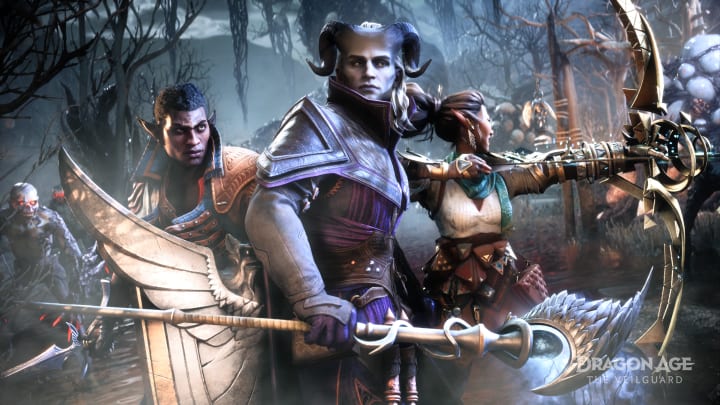Dragon Age: The Veilguard will make you cry

In my backstage hands-off demo of Dragon Age: The Veilguard during Summer Game Fest 2024, one moment makes onlookers cry out in shock.
It’s so hard-hitting, developer BioWare has asked us not to spoil it, but you get the sense it won’t be the only time your connection to a character gets tested. Ten years since Dragon Age: Inquisition, it speaks to the continued brilliance of BioWare’s talent in crafting compelling, memorable characters you’d do anything to protect.
Dragon Age: The Veilguard follows your custom character, Rook, as they attempt to stop two ancient demons unleashed by the Elven God Solas annihilating everything and everyone. Together with three companions of your choosing, you’ll journey through grand cities, forest ruins, and lush jungles on a mission to rescue the enigmatic fantasy world of Thedas.
Billions of lives may be at stake, but the emotional gut punches centre on the fates of a few: your friends. Lovable dwarf Varric returns, as does flame-haired warrior Lace Harding. They’re joined by new companions like the Veil Jumper Bellara, necromancer Emmrich, and the private detective Neve. We meet the latter early in the demo as Rook and co. enter a seedy bar on their search for Solas.
This leads to one of Dragon Age’s signature dialogue options. BioWare separates them into major and minor choices; major choices diverge the story, while minor choices add color to your character and develop rapport with people.
In this one, Rook can either peacefully ask the moody barkeep where Solas is, or demand it with the threat of violence. The implication of each option is clear so you know beforehand exactly what you’re getting yourself into: here you’re going to be talking or fighting.
A brawl breaks out and in runs Varric, saving the day with a volley of arrows. Next, there’s a minor dialogue choice when Varric asks Rook how he’s holding up after eating a few punches to the face. Rook can respond affably (“Never better) , irreverent (“A little shaky”), or tough (“I’m in a hurry”). These options are functionally meaningless since they don’t impact the story, but they’re fun to role-play with, fleshing out your character’s personality. Companions also remember what you’ve said and reference it later.
The main way you’ll inject personality into Rook, however, is, of course, with the in-depth character creator. It once again gives you four races to pick from: human, elf, dwarf, and qunari. For the first time ever, though, you can tailor your character’s bodily dimensions, fine-tuning muscle mass, shoulder broadness, waist width, and more.
BioWare’s paid particular attention to hair, using EA’s patented strand technology to ensure it reacts convincingly, whether flapping gently in the breeze or blowing back from the force of a magical explosion. Your character is seamlessly integrated into cutscenes, however bizarre you make them.
Your three classes are rogue, warrior, and mage, with three subclasses within each. For example, rogues have access to subclasses for melee-minded dualists, explosive-loving saboteurs, and sniper masters the veil rangers.
Your available factions are the Antivan Crows, Grey Wardens, Shadow Dragons, Veil Jumpers, Lords of Fortune, and The Mourne Watch. Each faction offers three unique buffs, like extra damage against certain enemies or the ability to slot an extra potion. Dialogue options also change depending on faction - at one point Harding refers to Rook as a member of the Shadow Dragons.
After the bar brawl comes the first proper battle, an encounter with supremacist blood cultists the Venatori. Combat is flashier than Inquisition but just as strategic. It blends responsive realtime combat with time-freezing tactical decision-making. You don’t take direct control of companions like past Dragon Age games, but can still pause and issue commands, whether ordering allies to attack, defend, or heal.
Creative companion combos are where The Veilguard truly impresses. You can select three for you and three per companion. When using the abilities wheel, time pauses so you can choose your move, not only for yourself but for your team. This is crucial in taking out enemies protected with magical buffs.
In the demo, Rook unleashes a burst of electric-blue static to fry one foe’s shields as Harper fires arrows to finish off their health bar. With four powerful heroes and tens of enemies on-screen, all reeling off colorful magic attacks, fights are often spectacular.
Next is where that emotional moment comes in, and it’s one caused by you. When Varric says he’s going to attempt to stop Solas by talking to him one-on-one, Rook can either encourage him or warn him not to. In my demo, the player selects the former option, and the shocking scene unfolds.
To be honest, it probably happens either way - it seems an unavoidable plot point - but BioWare gives you enough agency to make the world feel convincingly reactive. And sometimes, as in this case, what goes on in that world will make you have an absolute meltdown.
Dragon Age: The Veilguard launches Fall 2024 for PC, Xbox Series X|S, and PS5.
